Male Hypogonadism Market Research, 2030
The global male hypogonadism market size was $3.1 billion in 2020, and is projected to reach $5.1 billion by 2030, growing at a CAGR of 5.1% from 2021 to 2030. Male hypogonadism is a medical disorder in which the testes do not produce enough testosterone, resulting in a lack of muscle mass development, impaired body hair growth, development of breast tissues, and lack of voice deepening. It is the outcome of testicular issue or disorder that affects the hypothalamus and pituitary gland. Hypogonadism affects various organs and one's quality of life. The indications and symptoms of the deficiency vary depending on when it was initially developed, severity of the deficiency, and whether or not the primary functions of the testes are impacted.
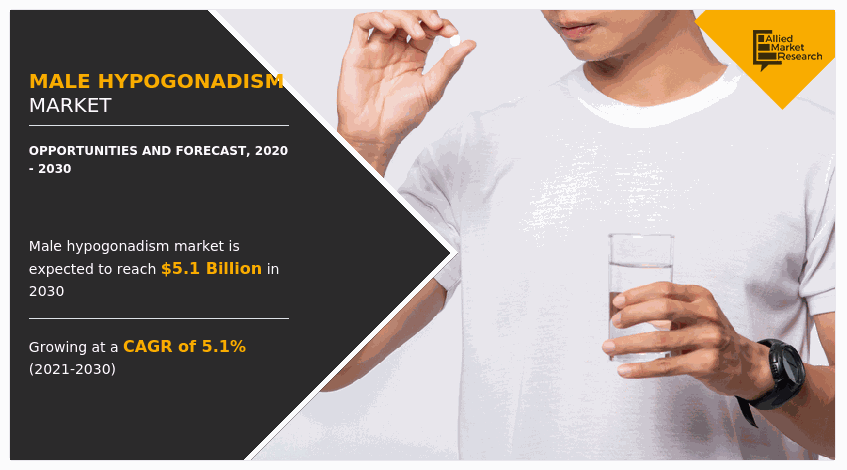
Male hypogonadism market trends include rise in prevalence and incidence of testosterone deficiency in males, increase in infertility rates, and surge in awareness of male hypogonadism treatment choices among the patient population drive the growth of the male hypogonadism market. Furthermore, risk of getting affected by hypogonadism is very high in the geriatric population as well as in the population suffering with obesity and diabetes. Thus, growth in geriatric population and rise in incidence of chronic lifestyle disorders, including obesity and diabetes drive male hypogonadism market growth. However, testosterone replacement treatment (TRT) hampers male hypogonadism industry, owing to severe adverse after effects of external testosterone hormone injection. Conversely, technological developments are expected to create new male hypogonadism market opportunity for growth during the forecast period. Thus, male hypogonadism market forecast looks promising owing to aforementioned growth factors.
Market Segmentation
The global male hypogonadism market is segmented on the basis of therapy, drug delivery and type. Depending on therapy, it is categorized into testosterone replacement therapy and gonadotropin & gonadotropin-releasing hormones therapy. The gonadotropin & gonadotropin-releasing hormones therapy segment is categorized into luteinizing hormone (LH), follicle-stimulating hormone (FSH), human chorionic gonadotropin (HCG), and gonadotropin-releasing hormone (GNRH). According to drug delivery, it is fragmented into topical gels, injectable, transdermal patches, and others. As per type, it is segregated into Klinefelter’s syndrome, Kallmann syndrome, pituitary disorders, and others. Region wise, it is analyzed across North America, Europe, Asia Pacific, and LAMEA.
Depending on therapy, testosterone replacement therapy held largest male hypogonadism market share in 2020 while Gonadotropin and Gonadotropin Releasing Hormone Therapy is anticipated to be the fastest growing segment in the forecast period
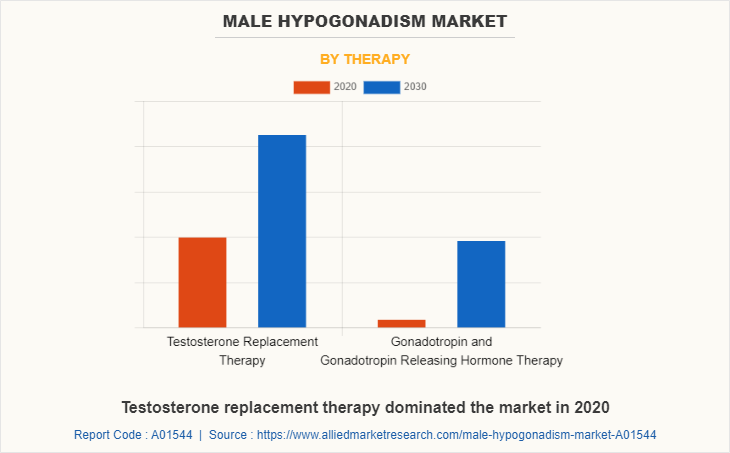
According to drug delivery, topical gels segment dominated the market in 2020 owing to rise in prescription of topical gels compared to other dosage forms. Moreover, transdermal patches segment is anticipated to be the fastest growing segment with a CAGR
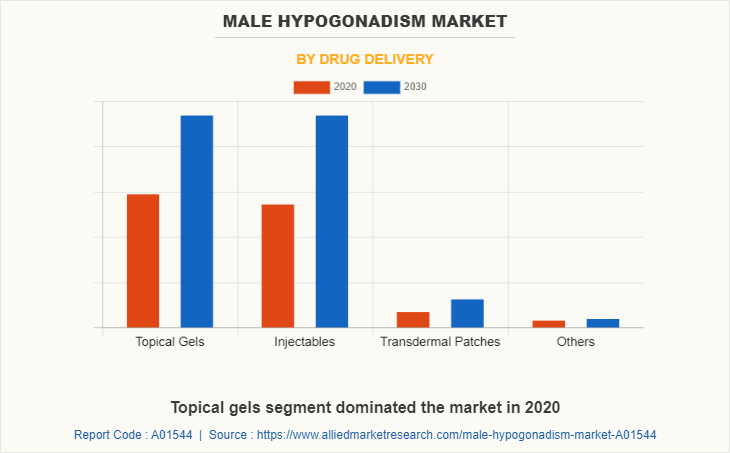
As per the type, pituitary disorder segment dominated the market in 2020 and is also expected to grow at highest CAGR of 5.8% during the forecast period. The growth of pituitary disorder segment is owing to surge in genetic disorders in aging population
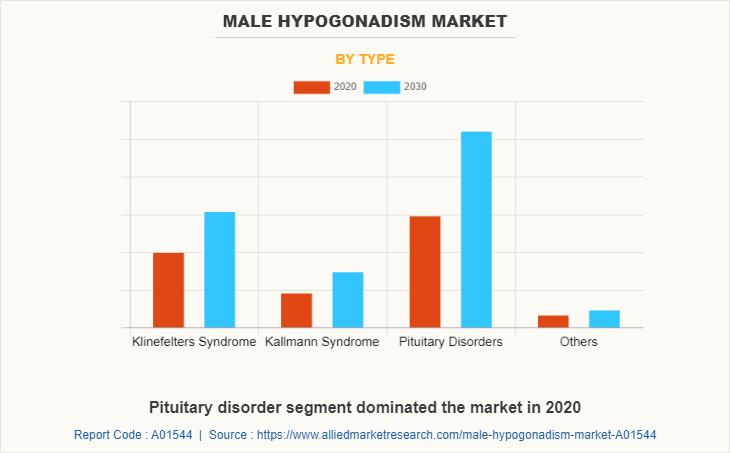
Region wise, North America dominated the market 2020 owing to increase in awareness campaigns of men healthcare and surge in primary and secondary hypogonadism cases. Asia-Pacific is anticipated to be the fastest growing segment with a CAGR of 7.9%, owing to the increase in number of people with medical expertise and surge in awareness schemes and campaigns for health of men.
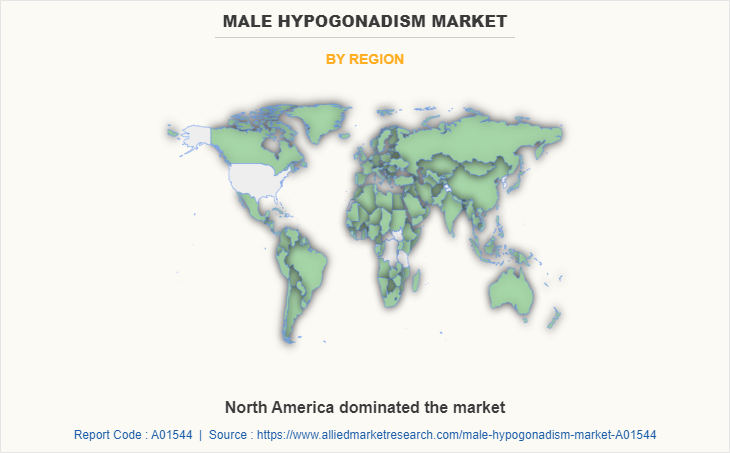
Major key players operating in the global male hypogonadism market are Allergan PLC., Bayer AG, Eli Lily & Company, Endo Iternational PLC., Ferring Holdings SA, Finox Biotech, Merck & Co. Inc., Pfizer, Perrigo Company PLC., Teva Pharmaceutical Industries Ltd.
Key Benefits For Stakeholders
- This report provides a quantitative analysis of the market segments, current trends, estimations, and dynamics of the male hypogonadism market analysis from 2020 to 2030 to identify the prevailing male hypogonadism market opportunities.
- The market research is offered along with information related to key drivers, restraints, and opportunities.
- Porter's five forces analysis highlights the potency of buyers and suppliers to enable stakeholders make profit-oriented business decisions and strengthen their supplier-buyer network.
- In-depth analysis of the male hypogonadism market segmentation assists to determine the prevailing market opportunities.
- Major countries in each region are mapped according to their revenue contribution to the global market.
- Market player positioning facilitates benchmarking and provides a clear understanding of the present position of the market players.
- The report includes the analysis of the regional as well as global male hypogonadism market trends, key players, market segments, application areas, and market growth strategies.
Male Hypogonadism Market Report Highlights
| Aspects | Details |
| By Type |
|
| By Drug Delivery |
|
| By Therapy |
|
| By Region |
|
Analyst Review
Hypogonadism is a condition in which sex glands generate insufficient or no sex hormones. The testes in men and the ovaries in women are the sex glands, often known as gonads. Secondary sex traits, such as breast development in women, testicular development in men, and pubic hair growth are all influenced by sex hormones. The menstrual cycle and sperm production are also affected by sex hormones. Gonad deficiency is another name for hypogonadism. When it occurs in men, it is known as low serum testosterone, male hypogonadism, or andropause.
Factors such as rise in prevalence of testosterone insufficiency among males drives the growth of the global male hypogonadism industry. Furthermore, rise in infertility rates and increase in awareness toward hypogonadism treatment among individuals fuel the growth of the market. Governments of several nations assist in raising awareness regarding hypogonadism treatment options, including testosterone replacement therapy, which assists in increasing product sales in the male hypogonadism market. Increase in prevalence of diabetes and obesity drives the growth of the market. Moreover, changes in lifestyle, such as increase in smoking and drinking habits and rise in stress levels among males between the ages of 25 and 40, results in lower estrogen and androgen levels, driving the growth of male hypogonadism market. However, several variables function as stumbling blocks to the market's expansion. After effects of the testosterone replacement therapies hamper the market growth. In addition, introduction of generics is expected to decline the sales of leading brands, limiting market growth. On the other hand, technological innovation, provide profitable business prospects to the market.
North America dominated the market in 2020, owing to surge in number of primary and secondary hypogonadism cases as well as increase in awareness among males about treatment alternatives. Apart from that, presence of a high-tech healthcare sector and highly innovative products help in maintaining the dominance during the forecast period
The factors that drive the global male hypogonadism market are increase in cases of hypogonadism, surge in awareness of hypogonadism, and rise in number of treatment options.
Testosterone replacement therapy is the leading segment in the male hypogonadism market owing to increase in number of male patients undergoing TRT.
The global male hypogonadism market is expected to reach $ 5,085.03 million by 2030
Major key players operating in the global male hypogonadism market are Allergan PLC., Bayer AG, Eli Lily & Company, Endo Iternational PLC., Ferring Holdings SA, Finox Biotech, Merck & Co. Inc., Pfizer, Perrigo Company PLC., Teva Pharmaceutical Industries Ltd.
North America dominated the market 2020, owing to increase in awareness campaigns of men healthcare and surge in primary and secondary hypogonadism cases.
Loading Table Of Content...



